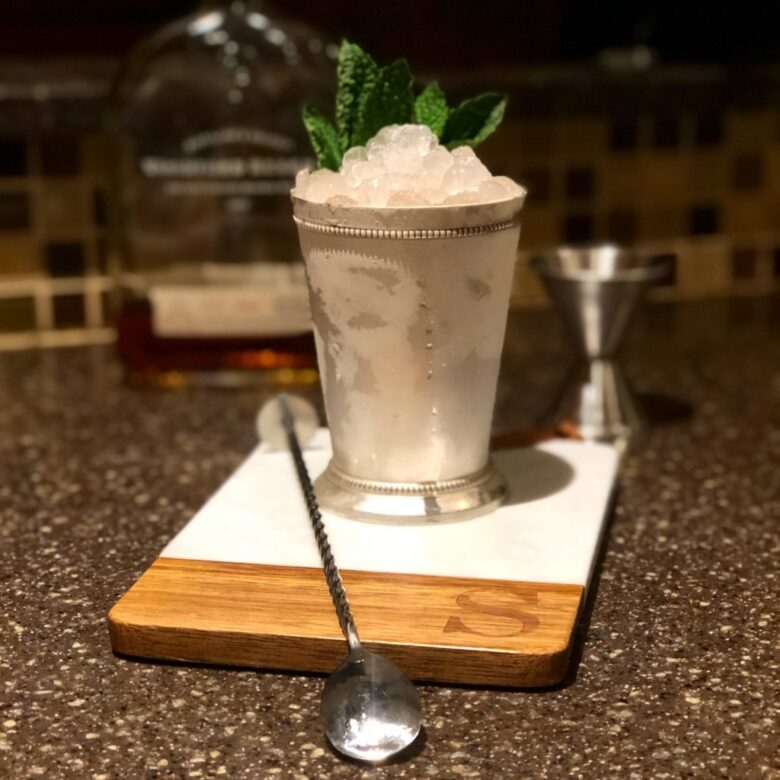The Mint Julep – recipe below.
Horse racing and drinking have had a symbiotic relationship – likely since someone was drunk enough to try to jump on the back of a wild horse. There is some irony in this, considering the term cocktail (cock-tail) comes from the 17th and 18th century (illegal) practice of shoving a peeled ginger root up an old horse’s butt to get it to prance around and fetch a better price as a younger horse.
The Kentucky Derby, which was run this last week after being postponed from spring, has a series of sponsored official cocktails with their proprietary spirits associated with it. Of course, everyone associates the Mint Julep with the Kentucky Derby. But did you know that the official Mint Julep of the Kentucky Derby is made only with Old Forester Bourbon? The Woodford Reserve Kentucky Derby (the Presenting Sponsor of the Kentucky Derby – yes, I know, it’s confusing) is run Saturday evening. But before the Derby is the Old Forester Turf Classic Saturday afternoon, the Kentucky Oaks (official cocktail: Finlandia Oaks Lily) run Friday, and the Thurby is run Thursday (official cocktail: Old Forester Old Fashioned). Oh, and the official cocktail for Churchill Downs is the Woodford Reserve Spire. The Black Eyed Susan is the official cocktail of The Preakness (which is surprisingly not The Preakness cocktail), the Belmont Stakes has the Belmont Jewel, and the Keenland has The Keenland Breeze. There is also the Turf Club, the Brown Derby, the Green Derby, the three known versions of the Jockey Club, and the Horse’s Neck to name but a few.

But no drink is as easily identified with racing than the Mint Julep. So where did the julep come from, and why the connection? Juleps are based on several millennia of medicine using mint and spirits. The name itself comes from the Persian word Golâb, meaning ‘rosewater’. This went through various iterations in several different languages: the Arabic julab, the Latin julapium, Spanish julepe, and the French julep, though not necessarily in that order. It has always been a sweet drink, but not alcoholic by nature. The English julep, considered medicine, was often prescribed as a treatment for nausea, vomiting, and difficulty swallowing. It may date to as early as the 1400s. It contained very little alcohol and often included camphor. But it took the Americans to move the drink from the doctor’s office to the bar.
The first reference to the American julep, which is a combination of spirit, sugar, mint, and water (no ice in the beginning), is from 1770, in a satirical play by Robert Mumford called ‘The Candidate’, with a drunken character ‘Mr. Julip’, as well as “A Short Poem on Hunting” (describing a julep as a concoction “Which doctors storm at, and which some adore”) published in the Williamsburg Virginia Gazette.

It was likely created in Virginia, but soon spread throughout the America southern states. By the first two decades of the 1800s, references were everywhere, aided by the newly created Ice Trade, shipping ice from the artic to the Atlantic costal states at first, then extending deep into the major cities of the US. The julip also gives us one of the first star bartenders. The first acknowledged Master of Mint Juleps (yes, that was a thing then) was Jasper Crouch from Richmond, who identified himself as a Free Person of Color. Any good southern hotel of social club of any accord would have a bartender who claimed to be a Master of the Julep. It is important that at this time, there was no specific spirit associated with the ice-cold beverage, greeting a southern traveler after a long coach ride. More often than not, they were made with Jenever, brandy, or rum. But whiskey and bourbon were American made, local, and cheap – so the transition was inevitable.

The direct link between juleps and horseracing began sometime around 1820 when the sterling silver julep cups are referenced as trophies to first-place jockeys. “It ties together two of Kentucky’s most well-known industries: horse racing and bourbon,” says Chris Goodlett, senior curator of collections at the Kentucky Derby Museum. The great-grandson of Meriwether Lewis (of Lewis and Clark), Meriwether Lewis Clark Jr. built Churchill Downs and inaugurated the first Kentucky Derby in 1875. He was a colorful character in Kentucky history, often starting arguments, and just as often ending them by pulling out a revolver. He is said to have offered a julep in a sterling silver cup to the Polish actress Helena Modjeska in 1877, who liked it so much she immediately ordered another.

In 1938 the Derby made it official by naming the Mint Julep the official drink of the Kentucky Derby. They sells as many as 120,000 mint juleps during the Derby (sadly, not this year), requiring 10,000 bottles of Old Forester, 1,000 pounds of mint, and 60,000 pounds of ice. For a two-minute race.
The Mint Julep (from above)
2-1/2oz Woodford Reserve Bourbon
1/2oz simple syrup
4-5 mint leaves
Mint sprig for garnish
Add mint leaves and simple syrup (or 2 sugar cubes) to a silver plated julep cup and muddle together. You want to break the surface of the mint leaves to release the oils, but not tear them apart. If you are too aggressive it will release a bitter taste from the mint. Add crushed ice (needs to be crushed ice, not cracked ice – but not shaved ice either) to the cup and add the bourbon. Stir until the cup frosts over. Add ice to create a mound and add a mint sprig for garnish. Serve – but be careful to only hold the cup by the base or rim, to keep fingerprints off the frosted exterior.
AotCB-008
Instagram@architecture_of_the_cocktail



